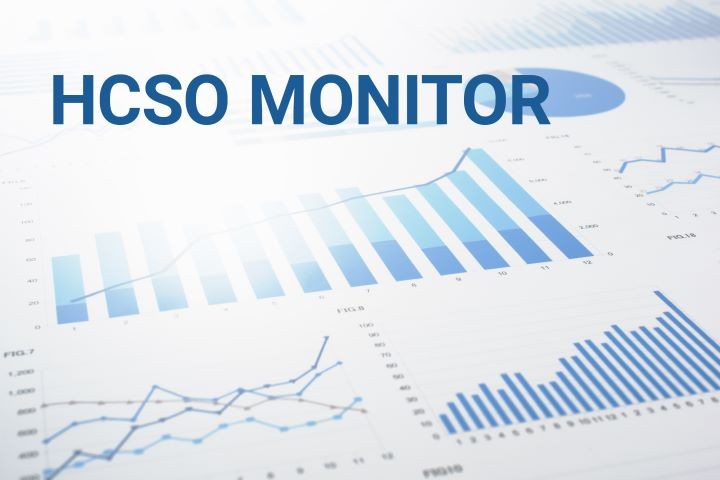Key figures
Inflation
Indicator description
Average change in the prices of goods and services purchased by households for own use, compared to the same period of the previous year. The consumer price index less 100 equals the inflation rate.
Source:
Summary tables (STADAT)
Latest data: –
GDP
Indicator description
Gross domestic product is the sum of gross value added produced by industries or sectors, valued at basic prices, and of the balance of taxes and subsidies on products, which cannot be divided by industry or sector, less financial intermediation services not divided by industry or sector. GDP volume change compared to the same period of the previous year is presented based on unadjusted data.
Source:
Summary tables (STADAT)
Latest data: –
Adjusted population
Indicator description
The full-scope censuses conducted every ten years show a comprehensive picture of the number and composition of the population. For determining the annual population number in the period between two censuses, the starting point is the population number of the last census (currently the census with the reference date of 1 October 2022), and from this, the population was estimated by using natural increase or decrease data available from the statistics of vital events until 2000. From 2001 international migration is also taken into account.
Source:
Summary tables (STADAT)
Latest data: –
Unemployment rate
Indicator description
The ratio of unemployed persons to the economically active population of corresponding age. The indicator can be calculated for different age groups, the default is the age group 15–74. Further selected age groups: 15–24, 25–54, 55–74.
Source:
Summary tables (STADAT)
Latest data: –
Employment rate
Indicator description
The ratio of employed persons to the population of corresponding age. The indicator can be calculated for different age groups, the default is the age group 15–64. Further selected age groups: 15–24, 25–54, 55–64 and 20–64.
Source:
Summary tables (STADAT)
Latest data: –
Industrial production
Indicator description
We measure changes of industrial production by variations of industrial production values, however the impact of price change is filtered out. We calculate the volume index of production based on comparative prices data of the industrial production value (presented at reference period price levels).
Source:
Summary tables (STADAT)
Latest data: –
Featured
HCSO Monitor
The collection of interactive figures provides up-to-date information on the latest domestic and international socio-economic trends.
The decisive part of the figures included in HCSO Monitor are downloadable in both image and data formats (PNG, SVG and CSV).
Feel free to browse the data in HCSO Monitor, updated many times a week!
Latest update: 10/07/2025
The decisive part of the figures included in HCSO Monitor are downloadable in both image and data formats (PNG, SVG and CSV).
Feel free to browse the data in HCSO Monitor, updated many times a week!
Latest update: 10/07/2025
Hungary 1st quarter of 2025
The performance of the Hungarian economy in the 1st quarter of 2025 was identical with the same period of the previous year’s level. Increasing performance in the service sector as well as the growth in consumption had a positive impact on the GDP. The continuing setback of the industry and construction, a subdued investment activity, the deterioration in the balance of the external trade counterbalanced this trend. Regarding the labour market, employment rate – considering the 1st quarters’ values – was the highest ever, while the unemployment rate lessened.
10/07/2025
10/07/2025
Snapshots, 2024 – Social protection
Over 1 million people received the family allowance on a universal basis in 2024. The role of child care benefit among family benefits is growing, thanks also to the increased possibility to work while receiving child care benefit. Nearly 70 thousand children were registered at risk, of whom 31 thousand minors were taken into child protection by guardianship authorities, which was the highest value in the last 10 years. The focus shifted from institutional care to placement with foster parents, with a significant increase in the role of churches.
08/07/2025
08/07/2025
Snapshots, 2024 – Prices
Consumer prices were up by 3.7% on average in 2024 compared to the previous year, and the rate of price rise significantly decreased compared to the 2023 figure (17.6%), being a 25-year peak. The deceleration in inflation was influenced by the rate of increase in industrial, construction and services prices going on lessening, and agricultural product prices going down again on average. External trade prices expressed in forints slightly rose, and minor deterioration occurred in terms of trade.
07/07/2025
07/07/2025
World Chocolate Day, July 7
July 7 is the World Chocolate Day. Hungary exported 28 thousand tonnes of chocolate in 2024, more than half of these were filled chocolate bars and solid chocolate ones. One-fifth of the approximately 50 thousand tonnes of imported chocolate was white chocolate.07/07/2025
Hungary, 2024 – macroeconomic environment
Our series of infographics, based on the most important data from the Hungarian-language publication Hungary, 2024 provides a comprehensive picture of the social and economic state of our country and the main characteristics of our environment. The first infographic in the series presents the main data of the macroeconomic environment. The English extract from the publication is available here: Hungary, 2024, and the full Hungarian-language version here: Magyarország, 2024.
04/07/2025
04/07/2025
Hungary, 2024
Hungary’s GDP increased by 0.5% amid global challenges in 2024. The performance of goods-producing industries lessened, while that of service-providing ones rose, which shows the duality of economic trends. Household consumption picked up, which was considerably encouraged by the purchasing power of earnings growing again with the inflationary wave calming down. Besides, the data series reveal that the level of employment reached another peak.
01/07/2025
01/07/2025
Snapshots, 2024 – Industry
The volume of domestic industrial production was 4.0% lower in 2024 year-on-year. Output lessened in nine of the – great majority of production ensuring - manufacturing subsections, most of all in the manufacture of electrical equipment. Output in the largest weight representing vehicle production decreased as well. Food industry, however, enhanced its performance.
01/07/2025
01/07/2025
29 June, Peter’s and Paul’s Day, beginning of harvest
According to popular tradition, 29 June, Peter’s and Paul’s Day, is the beginning of harvest, wheat becoming ready for cutting around that day. Hungary is one of the pantries of Europe, a substantial part of the production of a quantity amply exceeding the internal demand (typically some half of wheat) being sold on external markets. Following the decline after the regime change, the domestic average yields of ear cereals dynamically rose, which is proven by all of the 10 years with the highest specific yield for barley and rye and seven years – including the record, 2021 – for wheat following 2010.27/06/2025
HCSO–ingatlan.com-rent index, May 2025
In May 2025, rents increased by 0.8% in Hungary and decreased by 0.2% in Budapest compared to the previous month. The May rent index exceeded the 2015 base by 120% nationally and 109% in the capital in nominal terms, and by 28% and 22% in real terms, respectively. Over a year, nominal rents increased by 7-8% and real rents by 2-3%.
20/06/2025
20/06/2025
First releases
News, events
- Dr. Áron Kincses becomes habilitated associate professor at the University of Miskolc, 10/07/2025
- Dr Áron Kincses, President of the Hungarian Central Statistical Office handed over this year’s Fényes Elek Prizes, 04/07/2025
- HCSO publishes June motor fuel price statistics, 04/07/2025
- HCSO's published its annual summary publication Hungary, 2024, 01/07/2025
- Statistical data supply is our common cause, 30/06/2025
- Temporary suspension of personal customer reception, 25/06/2025









